Combining Flagstone with Other Materials
Design ideas for using flagstone in conjunction with wood, concrete, boulders & more By Maureen Gilmer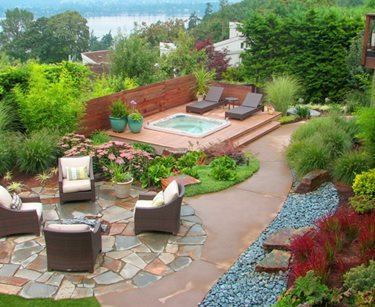
Use smaller fields of flagstone to add diversity to a paving scheme for more visual interest when viewed from the deck above.
In cool, rainy climates, the integration of flagstone can make a space more visually interesting. Rather than extending the poured, tinted concrete deck into the seating area, the flagstone changes the ground plane to a powerful multicolored field. The flagstone draws hues from its surroundings such as the burnt orange of the concrete and black Mexican beach pebbles. In this space the flagstone is an immediate eye catcher amidst this lush green ornamental grasses and accent plants necessary for the dynamic color vibration that makes the whole composition so visually exciting.

Don't underestimate costs of adapting flagstone to a crisp edge transition to wood decking.
Whenever flagstone is to intersect another kind of paving material, pay close attention to the point of transition. This lovely terrace demonstrates how costs can rise exponentially when construction of an intersection requires special skills. The edge of this circular patio must be perfectly cut to create this clean radius. The wood deck requires the underpinnings to be constructed adjacent to the flagstone footing to achieve this butt-edge. Neither the wood deck nor the flagstone lend themselves to curves this tight, and though it is visually lovely, the additional construction costs will be considerable.
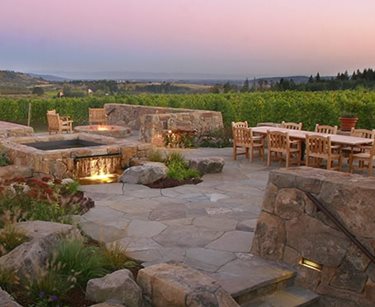
Choose a wall veneer stone that matches your flagstone to ensure the entire site is visually integrated on both the vertical and horizontal planes.
This outdoor living space has a lot going on with small patios, spa, water feature and fire pit which demonstrate the importance of site-wide material integration. Had any other material been used on the walls, elements might have appeared fragmented. Here flagstone is accompanied by a stone veneer on the walls, and even the landscape boulders themselves are similar. Only differences in form, texture and pattern offer variation without risking dis-integration. The key is to strive for visually similar materials choices when the same stone is not available for all applications.
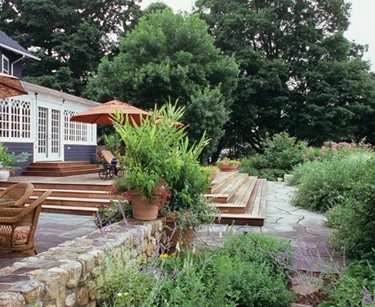
Flagstone is versatile enough to allow the same look on an on-slab upper patio and on-sand lower patio to solve varying grade limitations of sloping sites.
Here two levels of flagstone are used in different ways to meet grade in this difficult site. The upper wood deck takes up most of the grade change from doorway down to the upper flagstone-on-slab with mortar joints that make it easy to slide chairs around in this dining area. The lower flagstone patio is set on sand to transition from deck steps to the adjacent garden grade. When there is no under slab it is far easier to build the deck steps over the flagstone edge, sinking footings as required. Here the versatility of flagstone lowers construction costs by simplifying and integrating a complex series of grades.
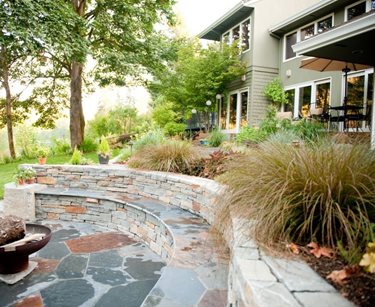
Repeat flagstone paving on seatwalls and other surfaces to avoid too many variations in a small space.
When there's a lot going on in a small space, avoid unnecessary changes of material. Here a seatwall is integrated into the retaining wall, and its seating surface is identical to the flagstone of the patio floor. Seatwall surfaces must be smooth and comfortable, so all too often tile or other choices are used in such applications. In this case the flagstone is naturally smooth, so it makes a good choice to repeat on the seatwall. But whenever this is done, pay close attention to the size and detail of the mortar joints. Keep them as narrow and precise as possible because mortar or grout contains sharp sand that can easily snag fibers of clothing if not carefully hand finished.
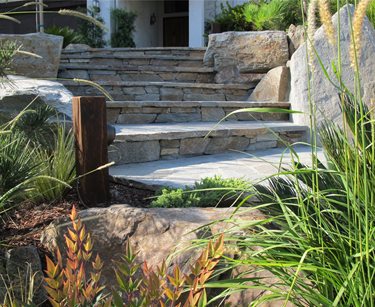
Flagstone is the ideal choice when paving is built right up to and around boulders for a very natural, yet precise change in grade.
Rather than leaving the ends of these flagstone steps open, this designer chose to build them right into these boulder cheek walls. The boulders act as retaining walls to take up grade without footings for a condition prevents runoff building up soil or mulch in planted areas adjacent to these steps. Flagstone is ideal for a smooth transition from step to boulder due to the irregular shape of both. The use of stone on the step riser takes this concept further for an entry that appears perfectly natural, yet is as low maintenance as a dull poured concrete series of steps and retaining walls.
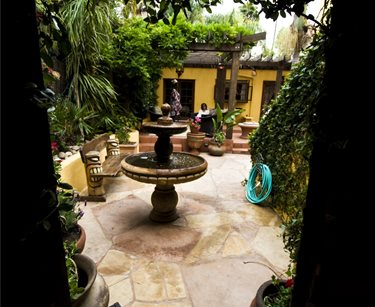
To eliminate the potential for stains, select dense flagstone that resists them, and is tolerant of an occasional steam clean.
Whether its water stains from a fountain or oil from food dropped in dining or grilling areas, know in advance how your stone choice will tolerate these potentially disfiguring problems. Stain prevention is the reason why planting or pots are often designed around fountains. Where water quality is poor or mineral rich, or where moss and algae crop up on every damp surface, there will be problems unless the design allows for them. Choose only very dense, impervious flagstone that does not absorb water or oil and is tolerant of an occasional pressure wash or steam cleaning. Porous flagstone used here already shows a ring of discoloration around the fountain.
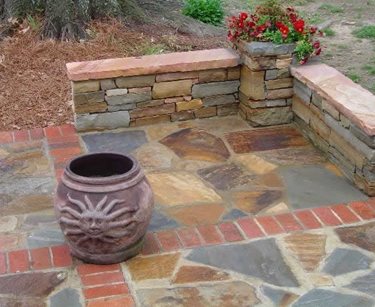
Avoid breaking up flagstone fields with straight lines that foil its naturally irregular look.
Flagstone is considered a high end paving material. Brick is not. Integrating brick into a flagstone patio forces the irregular patterned stones into smaller squares as shown here, which does not allow its natural beauty to shine through. Think twice before adding division lines to flagstone paving because it is already quite busy - like a crazy quilt - so adding accent bands may not be money well spent. Any time flagstone must abut a straight line as with these brick bands, the stone must be cut more often, which increases labor costs considerably.
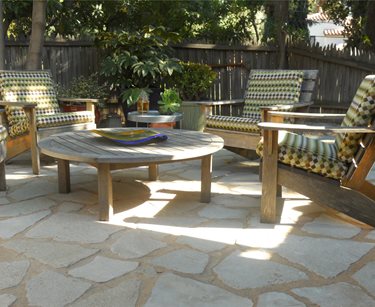
Combine flagstone with sturdy wooden furniture.
On this patio, solid wood chairs and a coffee table create a gathering place. The flagstone joints are filled with decomposed granite, which holds together much like mortar. Notice that the chair and table legs are wide enough that they won’t get stuck in the joints between stones. The flagstone and the furniture work well together to create a relaxed and family friendly space.
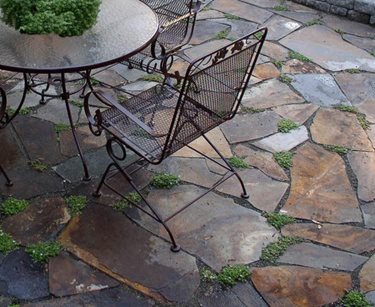
Avoid furniture with small legs on a patio with planted joints.
This striking patio is a wonderful example of fine flagstone work. However, the furniture is not well suited for use on flagstone. Unlike the previous example, these chairs have tiny legs that can become stuck in the joints and cause damage to the edge of the stones or the plants that grow between them. These chairs would be more appropriate for use with mortared flagstone.

 Backyards
Backyards
 Front Yards
Front Yards


